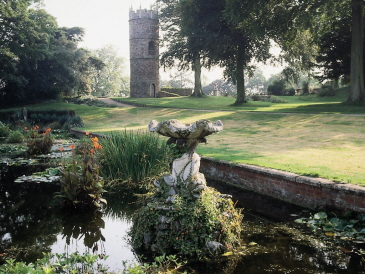Although Goldney Gardens is largely a hidden gem, nestled away at the top of Constitution Hill, it was brought to the attention of millions after featuring as the wedding venue for Dr Watson’s marriage to Mary Morstan in Sherlock last year.
Historian and blue badge guide Angela Nutbrown will give a unique insight into the history of the ornate garden later this month on 17 May and then on various dates until 23 August.
The tour will take in the exterior of the orangery, a heritage orchard, a statue of Hercules, the canal and tower, a rotunda and bastion, Corinthian columns and the elaborate grotto, which is one of the finest surviving examples of an 18th century garden grotto in Britain.
Alan Stealey, Head of External Estates at the University of Bristol, said: “I always look forward to the summer and the opportunity to walk around Goldney Garden while it looks its best. The garden really is a hidden oasis within Clifton.
“It was really exciting for the orangery to be used as the wedding venue in Sherlock – another chapter in the garden’s rich history. Very few people realise just how substantial the gardens are, let alone the existence of the grotto which is just such a rare and magical sight to behold.
“The tours offer the perfect way for people to appreciate the features and landscape while learning more about Bristol's maritime and industrial past.”
The Goldney family first came to live in the property in 1694, when Thomas Goldney II rented it. He later bought the property in 1705 before rebuilding the house and adding to the garden in the 1720s.
However, most of what we see today was the work of his son Thomas Goldney III who enlarged the garden to 16 acres in over 35 years.
The Grotto itself was completed 1764, 27 years after work began. The walls and pillars are covered with a variety of rare minerals, shells, corals, rocks and fossils, some of which may have been brought back to Bristol by Captain Woodes Rogers.
The central chamber houses a life-size lion with a lioness sitting in a den behind. There’s even a river god overlooking the rock pool.
In 1760, the Orangery was constructed to house an exotic collection of citrus trees which would have been brought to Bristol by merchant ships.
The garden at Goldney garnered a reputation as one of the must-see gardens of the 18th century, with both visitors and writers.
Goldney was later owned by two eminent supporters of the University of Bristol, first by Lewis Fry in 1864 and then by George Wills in 1921. In 1956, the property was sold to the University of Bristol and it became an annex to Clifton Hill House, providing accommodation for 29 female students and a tutor.

